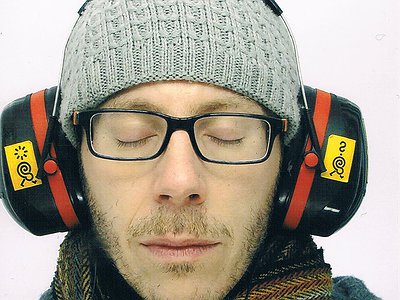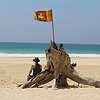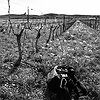Name: Stéphane Marin
Nationality: French
Occupation: Sound(scape) Artist / Walker / Listener
Current Release: "Serendib rythms" on Unfathomless;
Recommendations: "Matins d'Ariège" – Galavena
Books:
Cathy Lane - Angus Carlyle “In The Field: The Art of Field Recording ”
Anne Cauquelin - “L'invention du paysage”
Website / Contact: If you enjoyed this interview with Stéphane Marin, visit his website for information, resources and music.
When did you start writing/producing located / contextual sound works - and what or who were your early passions and influences? What is about music and/or sound that drew you to it?
Before composing, I was writing formal poetry and studying philosophy, focused on the “philosophies of dialogue“ (rencontre). After a couple of years of being engaged more physically with my body (dance, yoga, shiatsu ...), I started to compose some “DrAme'n Bass” cinematic music in 1999 under the name of Cynik. My first influences were Amon Tobin and a lot of artists on the Ninja Tune label. Abstract Hip Hop artists like DJ Krush, DJ Cam and DJ Shadow also inspired me. I was listening to a lot of Warp productions, too. But my first love in music was The Cure, and my early guru: Robert Smith ...
After many collaborations - like electronic sound poetry (L'Ovni Tendre) or “blind cinema for the ears” (La Collecte) - I met Pierre Sauvageot who invited me to follow him in his “Music de Ville” (City's Music) adventures. Enlarging my stereo universe to 8 channel performances in the urban public spaces, I started to decrease my manic addiction to compose breakbeat stereo music ... Then, people like Michel Risse or Serge Delaubier crossed my urban contextual Street Arts' road.
In 2008, after composing multi channel music/sound works for site-specific dance and theatre creations (Osmosis Cie – Deuxième Groupe d'Intervention), I decided to create my own company: “Espaces Sonores” dedicated to contextual sound creations for/in and with public spaces. I thought - at this moment - that contextual site-specific (sound) works were rare in this artistic landscape; I decided then to compose in a closer porosity with the “real” (=sound environment).
Here I found my greatest influence: the sounds of the world - all the sounds of the environment - without any aesthetic discrimination ... My artistic path crossed irremediably the “field recording”/phonographic based composers, especially the well known Jez Riley French and Yannick Dauby; and, quickly, a legion of others composers/recordists attached to listening, recording, composing with located sounds.
For most artists, originality is first preceded by a phase of learning and, often, emulating others. What was this like for you? -What is the relationship between copying, learning and your own creativity?
Indeed, when your work tends to be a resume of “listening”, you could imagine all the hours/days/weeks/months/years of listening which have shaped, modulated, then matured your own sense, your skills and finally your art of listening. For me - who came from poetry and philosophy (more than music) – listening (to other thoughts or to poets' scansions/rhythms) was the very first step to engage me on my own path. I was effectively very influenced by my masters (from Diogenes to Jankelevitch via Nietzsche, like from Verlaine to Ghérasim Luca via Francis Ponge ...). I tried to think with their concepts (or try to write with their flows ...), but they also taught me to try to think (& write) by myself. So, as soon as I started to feel imprisoned in the “philosophical sect”, I passed my way (on the invitation of my Master Daniel Charles) and found in music composition and sound art a new creative way to engage my thoughts in acts, to really live my thought and to give the chance to my listening not to be limited by the syllables of words ...
When you become a young self made musician, when the computer is the (only) entrance door (instrument) to your musical practice, when you finally discover the high level of these skilful talented beatmakers like Amon Tobin, Aphex Twin or Autechre, you might feel very disappointed when you try to copy them and listen to the abyss that takes you far away from them ... Here, you have three solutions: 1_Suicide 2_Working hard to become a clone 3_Find your own way. So (instead of killing me me), I started to work very hard to be able to learn about (a few of) their techniques and try to find my own way: elsewhere!
When I started to compose “sampled music”, I was sampling “everything”: music CDs, movies, radio broadcasts, sound effect libraries ... In 2000, I bought a mini-disc and a stereo microphone (SONY ECM-MS907) and started to record “everything” in my daily life environment. I did it with no presuppositions (or skills), only with my two ears, and a kind of awareness of serendipity. Then I was able to start to compose my own music with my own samples (also mixed with “stolen” samples). For years, I brought my recorders (MARANTZ PMD 670 then ZOOM H4n) and my microphones (RODE NT4 then BEYER MC 930) everywhere I went, and I kept developing a DIY passion to “sound recording” (which I called - without knowing anything about the existence of field recording or phonography practices - “writing of sound recordings”.)
I spent those years (2000 > 2012) developing my own sensibilities with field recording without having to “suffer” any other influence (or inspiration)! Then, after composing a couple of multichannel electro acoustic pieces for theatre and dance in urban spaces; after developing contextual soundwalks dealing with the porosity of the real sonic environment based on field recording re_compositions, I decided in 2012 to keep away from this ”autistic artistic“ attitude. I created a Facebook account and then quickly discovered that a community of “sound recording writers” existed ! I started listening to them, to meet them, and begin to accept to be influenced by them! But when you've passed a long time without influence you become less porous! As I discovered that we were a lot of sound artists working with environmental sounds (centripetal movement) - I was also understanding that the creative use of these recordings was “proteiform” and that we were all working in a lot of different directions (centrifugal movement). The reading of “In the Field: The Art of Field Recording“ was another spring to emulate myself in the unknown field of these practices and to start to make a point on my own “démarche” in regard to others, to understand when I was “reinventing the wheel”, and where was the real originality of my own creativity. Then I kept walking and continued to dig my own path. Now, in my recent curatorial work, I humbly try to stimulate the community by inventing collaborative projects (“Each Morning of The World“) and try to do my best to highlight all these brilliant sound works worldwide.
What were your main compositional- and production-challenges in the beginning and how have they changed over time?
At first I, was interested in people listening to my compositions. Now, I want my compositions to invite people to listen. I'm now considering that my compositions are a simple medium between the world and the audience's ears. My artistic path started with music, then progressed with sound art and, now, I am at the frontier between sound art and listening art ... Sometimes, I am talking about my job as a “listening composer” or "composer of listening".
In my first works, I was interested in cinematic music compositions that reveal a real “dramaturgy“, something that deals with tensions and suspense ... A music that makes you feels that something (maybe “everything”) might happen and takes you somewhere else or deeper into the here. I was talking about “DrAme'n Bass“ ... or “Cinematic Breakbeats“. What I wanted at this time was to bring THE audience into MY world. Now I am more engaged to invite MY audience in THE world!
I am particularly interested in the physical aspect of sound (its pure energy: the simple sensitive way we are experiencing the waves, the vibrations). I am also interested in questioning the borders between sounds and noises, the limits between the pleasant and the disturbing. I like to explore the porosity between natural and human sounds. And, finally, I am more and more interested in the poetry of banality than the poetry of the extraordinary!!!
That's why I am ever more interested in listening to a slug walking than a wild animal roaring. Everyone has already listened to a lion, nobody has ever listened to a slug. Our everyday environment is full of sound surprises, we just need to take the time to listen and, sometimes, we need to use some specific tools to encourage us to listen deeper ...




